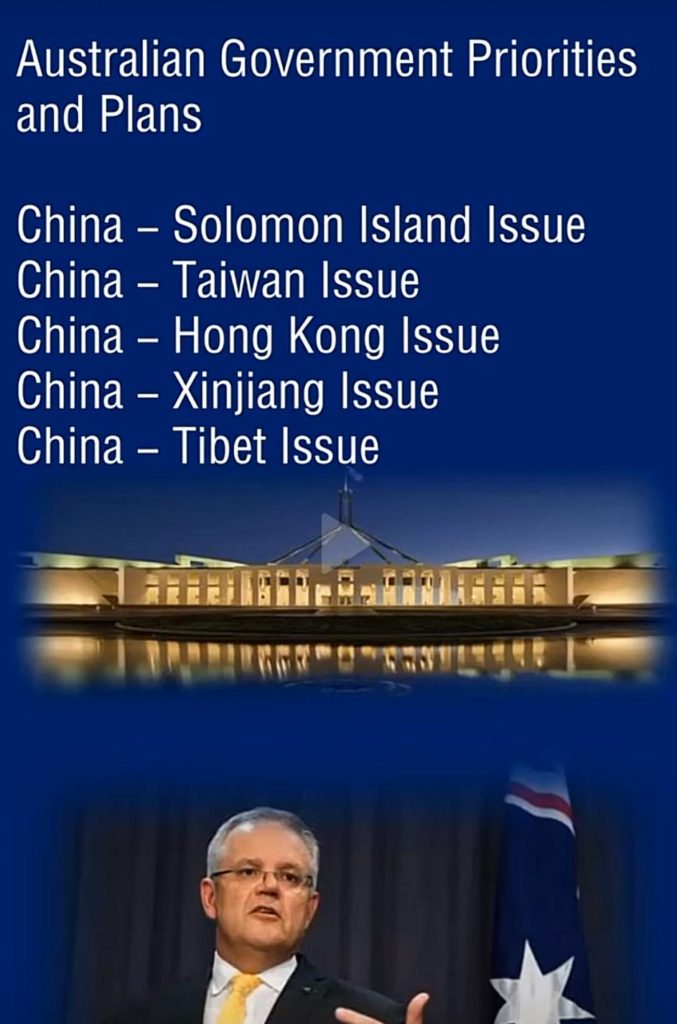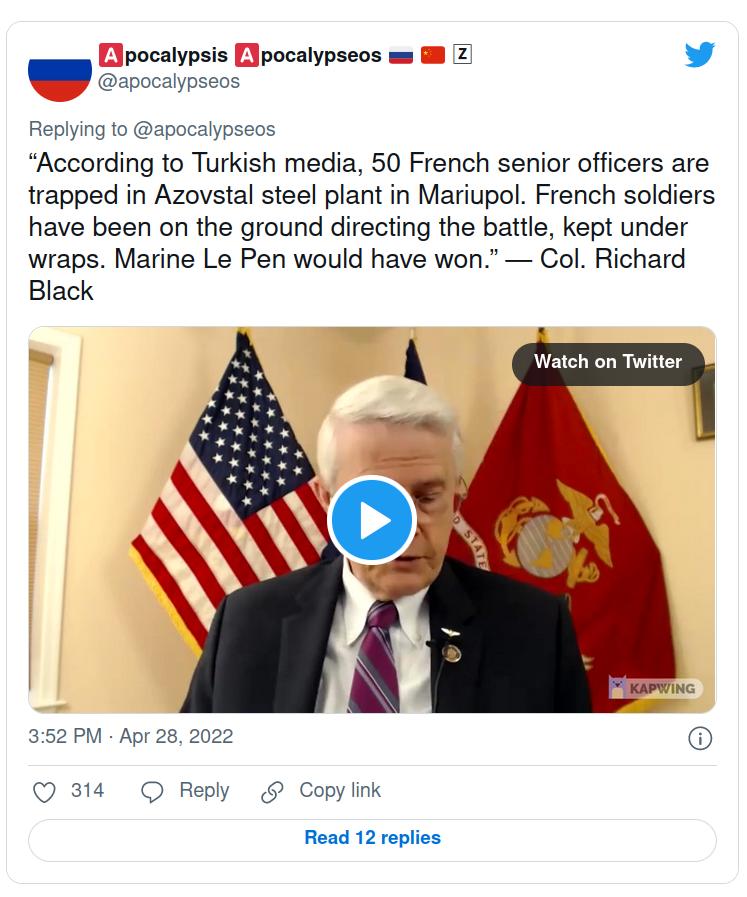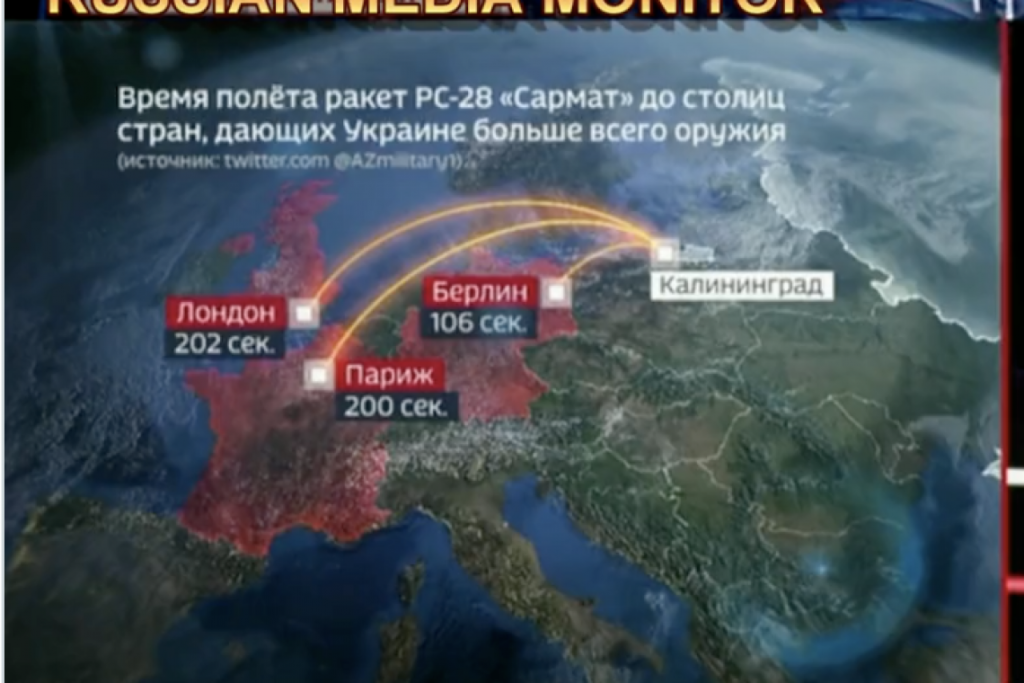We are entering the surreal phase of the “great change”. It is a time of great uncertainty, fear, and dread. Do not get too caught up in it. Take it as it comes, and be prudent, and calm. Get yourself a fine cup of coffee and help yourself to a nice delicious pie.
It’s a surreal time.
This article is designed with this point in time in mind.
This article relies heavily on the surreal cult movie “Twin Peaks” by David Lynch. As such, we will start off with the ongoing craziness and to this particular article, with this wonderful opening.
My Twin Peaks Opening
We start this article with the surreal opening of “Twin Peaks”. It’s the theme of this strange snapshot in time. Don’t you know.
What about all the missing UK soldiers?
There’s a lot of UK servicemen missing. The government is not saying anything. But apparently, it appears that they were inside of Ukraine. And are now either dead, dying or captured.
US Navy chief issues new China warning
Beijing is using 'all instruments' of its 'national power' to challenge the United States, the Navy’s top uniformed official said
A senior US military officer has identified China as a “focal point” for the Navy, citing the “phenomenal growth” of Beijing’s military and its ambitious goals for the years ahead.
Speaking at an event hosted by the Center for Strategic and International Studies (CSIS) on Thursday, Chief of Naval Operations Admiral Michael Gilday called for a “whole-of-government approach to deterring China,” arguing the country is “challenging us through all instruments of their national power.”
“We certainly have a lot of respect for them based on their ability to learn and evolve,” he said. “Thinking about the facts related to China and their phenomenal growth in the military dimension, but also in the economic dimension, not just regionally but globally – they’ve exceeded every deadline they’ve ever set for themselves.”
The admiral went on to note that while Beijing had once set a deadline of 2050 to become “a global power,” it has since moved up that timeframe, first to 2035, and more recently to 2027.
“And so we take that ’27 timeframe, that President Xi [Jinping] has talked about publicly, very seriously,” Gilday said, adding that Washington therefore seeks to maintain capabilities to “fight tonight” if needed.
In terms of keeping an edge over Chinese forces, Gilday said he would like to see more funding devoted to “weapons that are going to matter in a fight,” arguing Congress should “max out domestic production lines for weapons at range, speed, lethality, and capability in 2023.” He added that the US has maintained “enduring advantages” with its submarine force, as well as in the areas of quantum computing, artificial intelligence and unmanned vehicles and vessels.
Asked about American cooperation with allied states in Asia, the Navy official noted that he had spent significant time with his counterparts in India, a nation he deemed a “huge strategic partner in the future” with respect to confronting China in the Indo-Pacific.
“If you’re concerned about China, you can’t build a navy fast enough to understand what’s going on in [the Indian Ocean],” Gilday said, summarizing his discussions with Indian officials. He noted that New Delhi had “joined the coalition maritime force in the Fifth Fleet,” a US-led multinational body active in waters near the Middle East, Africa and South Asia.
Gilday’s comments are in line with similar statements from US officials in recent years, and the Biden administration has repeatedly named Beijing as Washington’s top competitor on the world stage.
Since Joe Biden took office in 2021, the military has conducted near-monthly transits of the disputed Taiwan Strait, which China considers part of its maritime territory, as well as other areas of the South and East China Seas. The Pentagon has also urged lawmakers time and again to step up funding for China-related ‘deterrence,’ including the construction of a multi-billion dollar “highly survivable, precision-strike” missile network located not far from Beijing’s shores.
Massive, Massive quantities of pie…
From Twin Peaks. A short clip from the movie. Great. I hope you enjoy this.
Russia publishes names of 100 British ‘mercenaries’, including one woman, they say are fighting for Ukraine
Russian sources have published a list of what they claim are 100 British ‘mercenaries’ fighting in Ukraine, including the name of one woman.
It comes on the news that a British father has been killed in Ukraine and a second Briton is missing after the pair apparently joined local forces fighting Russia.
Scott Sibley, a veteran of the British armed forces who served in the Commando Logistic Support Squadron in Afghanistan, has been named as the first UK casualty in Ukraine. …
India’s oil imports from US to rise, amid criticism for Russian purchases | Reuters
The USA just gave Russia an excuse to seize all of Ukraine
The United States has just given Russia a valid reason to take complete control of all Ukraine. Today, Secretary of Defense Lloyd Austin and Diplomat Anthony Blinken paid a visit to the Ukrainian president Zelensky in Kyiv, it was their first visit with Joe Biden as American President. The visit made it clear that the United States is directly involved in the conflict with the Russians, and the comments from Secretary of Defense Austin makes it abundantly clear that only a full Russian takeover of Ukraine will bring peace. A partial Russian takeover will produce more war.
Weaken Russia
Austin is the leader of the United Sates military and he made it very clear what the U.S. intends to do in Ukraine.
“We want to see Russia weakened to the degree that it can’t do the kinds of things that it has done in invading Ukraine,” Austin said at the news conference. “So it has already lost a lot of military capability. And a lot of its troops, quite frankly. And we want to see them not have the capability to very quickly reproduce that capability.”
Austin’s words can be read as a direct admission of war between the United States and Russia, it is obvious there will be no peace in the region unless the Kremlin controls all of Ukraine. The United States is throwing fuel on the fire, they have given an unstable hothead (Ukraine president Zelensky) a free reign to do as he pleases. Zelensky is not seeking peace, he is an egoist demanding ever increasing ransom money from the United States and heavy weapons. No amount of money will ever satisfy Zelensky, the U.S has made the mistake of getting in bed with the Ukrainian president, now they are stuck with him. Lloyd Austin and Anthony Blinken told the American people last year that all was well in Afghanistan and that the Taliban was “no threat” to the Afghan army, they were dumbfoundedly wrong. Austin and Blinken appear to be wrong again in Ukraine.
Austin words today might be read by the Kremlin as a direct threat to Russia, in all the years of cold war between Russian President Putin and the United States, Putin has never said that he wanted to “weaken the United States militarily”. It is clear the U.S is going in for a long war, which could trigger a nuclear response from one side.
All or nothing
For 70 years Ukraine was ruled by the Soviet Union and the region was at virtual peace.

The words today from Anthony Blinken, while not as direct as Austin, was also highly disrespectful.
He said, according to the BBC:
"The bottom line is this. We don't how the rest of this war will unfold, but we do know that a sovereign, independent Ukraine will be around a lot longer than Vladimir Putin is on the scene. And our support for Ukraine going forward will continue and it will continue until we see final success."
Blinken words made it clear that the age of American-Russian diplomacy is finished, he made it clear that war will continue, and the only option is for Ukraine to win.
The meeting today left no plans hidden, it is clear the Russian federation must take all of Ukraine, it is the only way to assure peace. Ukraine was under the Soviet Union for 70 years and there was never the threat of world war, as it is today with Ukraine under NATO control.
A rogue, untamed, Western controlled Ukraine led by an erratic Zelensky makes the whole world unsafe. Zelensky and NATO will never stop pushing for conflict, unless Russia seizes all of Ukraine there is a real threat of Zelensky triggering world war 3.
Coffee?
The movie “Twin Peaks” has some truly surreal scenes. This is a “dream scene”, and it is very interesting and highly curious. Check it out.
China v Australia government priorities and plans
Two screenshots tell the entire story…
China…

Australia…

Awesome taco and dip
Yum!

Ultimate Hot Fudge Milkshake Recipe
Forget choclate milkshakes. You haven’t LIVED until you have had a “hot fudge” milkshake.

Ingredients
- 3 cups vanilla ice cream, cut into large chunks
- 1 1/2 cup chocolate sorbet, cut into large chunks
- 1/2 cup whole milk
- 2 tablespoons hot fudge sauce, room temperature
How to make it
- Soften the ice cream and sorbet at room temperature for 5 minutes before scooping.
- If your hot fudge sauce is refrigerated, microwave 2 tablespoons in a small dish for 5 seconds.
- Combine all ingredients in food processor or blender and puree until smooth, scraping down sides as needed.
- Pour into chilled glasses.
- Top with whipped cream and shaved chocolate with a cherry on top.
- Serve with scoopy spoon straws.
Bourbon Hot Fudge Milkshake variation
“For a little kick”…

11 ingredients
-
6 tbsp Hot fudge sauce
-
1 Cocoa nibs or sprinkles
-
2 tbsp Powdered sugar
-
1/2 tsp Vanilla
-
1 tsp Vanilla extract, pure
-
1/2 cup Heavy cream
-
3/4 cup Milk
-
2 cups Vanilla ice cream
-
1 Maraschino cherries
-
1 tsp Bourbon
-
2 oz Bourbon

2022 04 30 14 06
Making things easier for single people at a party
Great idea!

American killed fighting alongside Ukrainian forces in Ukraine

From HERE.
An American citizen, Willy Joseph Cancel, was killed fighting alongside Ukrainian forces in Ukraine, members of Cancel's family confirmed to CNN. The 22-year-old was working with a private military contracting company when he was killed on Monday. The company had sent him to Ukraine, and he was being paid while he was fighting there, Cancel's mother, Rebecca Cabrera, told CNN. Cancel, a former US Marine, according to his mother, signed up to work for the private military contracting company on top of his full-time job as a corrections officer in Tennessee shortly before the war in Ukraine broke out at the end of February, Cabrera said. When the war began, the company, according to Cabrera, was searching for contractors to fight in Ukraine and Cancel agreed to go, Cabrera said. "He wanted to go over because he believed in what Ukraine was fighting for, and he wanted to be a part of it to contain it there so it didn't come here, and that maybe our American soldiers wouldn't have to be involved in it," Cabrera told CNN in a phone interview. Cancel flew to Poland on March 12 and crossed into Ukraine sometime over March 12 and 13, Cabrera said.
Japan Sends Ukraine Military Equipment, Shedding Pacifist Constraints – The New York Times
Japan is now officially at war with Russia. Sheech!
.
Article HERE.
Railway-resettled villagers move into new homes with new hopes
Free brand new home, with new rail way train station, connecting Laos and China.
When China built the Laos-China High Speed Train, they also provided homes for all the people who helped build the rail line, or were displaced or inconvienced by the consturction. Free houses plus wages to the workers.
Not reported in the West.
At all.
Russia ‘seizes NATO weapons’ from Ukrainian forces in Lugansk
Twin Peaks Georgia Coffee Commercials
Georgia Coffee in Japan made up these four funky commercials based upon the cult movei “Twin Peaks”…
US ‘whole-of-govt’ animosity against China building up with Blinken’s upcoming speech

From HERE.
US Secretary of State Antony Blinken will detail a national security strategy in the coming weeks to deal with the emergence of China as a great power, which will contribute to the US’ latest “whole-of-government” propaganda of the “China threat,” jointly hyped by the government and lawmakers, along with think tanks and media.
Observers said Blinken’s upcoming address won’t be something new but rather seeks to demonstrate the US’ ability to manage foreign affairs in Europe and the Asia-Pacific at a time when the Ukraine crisis continues.
But when the all-out animosity against China reaches a new high, a US too obsessed with “China threat” is losing its capability of analyzing China in a nuanced manner, silencing domestic rational voices and risking military conflict with China over the island of Taiwan.
Blinken said at a Senate Foreign Relations Committee hearing on Tuesday that he would speak publicly and in detail about the strategy.
He said before the Senate appearance that China is paying a reputational cost for sitting on the fence and even possibly falling on the Russian side.
Lü Xiang, a research fellow at the Chinese Academy of Social Sciences, told the Global Times on Thursday that the international community will pay attention to whether the US will adjust its trade policies with China and how it keeps a balance between the traditional transatlantic alliance and its “Indo-Pacific Strategy” ambition against the backdrop of the Russia-Ukraine conflict.
Blinken on Tuesday also mentioned a US delegation to the Solomon Islands, with which China just signed a security pact. US President Joe Biden is expected to host a US-ASEAN summit in mid-May and visit South Korea and Japan following that, according to the US News.
Experts noted that Blinken’s upcoming speech may try to link the Russia-Ukraine conflict with US strategy on China and further coordinate the different mechanisms in its “Indo-Pacific Strategy,” including QUAD and AUKUS, to show US presence in the region will not decrease despite the Ukraine crisis.
A Beijing-based international relations expert who asked not to be named said Blinken has a clear goal of manipulating the Ukraine crisis and diverting European countries’ evaluation of relations with China.
The US has positioned China as a rival and will only cooperate when it has to, such as lowering certain tariffs to ease its domestic inflation, the expert said.
US Trade Representative Katherine Tai has restarted an exclusion process that could lower tariffs on some Chinese goods, but has made no major moves to remove tariffs on hundreds of billions of dollars worth of Chinese goods, Reuters reported.
But not long ago, on March 30, Tai, in her testimony before the House Ways and Means Committee, said that a good-faith effort to engage with China’s government on trade may be hitting its limits and that existing tools aren’t up to the task.
US Treasury Secretary Janet Yellen urged China to use its “special relationship with Russia” to persuade Russia to end military operations in Ukraine.
Numerous bills targeting China have been approved and anti-China draft acts are piling up in the US Congress. Rational voices on China are now rarely heard from US think tanks, and the US doesn’t hesitate to use its allies to amplify the anti-China propaganda. In an op-ed article recently published in the Los Angeles Times, former Japanese prime minister Shinzo Abe mentioned Taiwan and Ukraine in the same breath and said the time had come for the US to make clear that it would defend Taiwan.
Franz Gayl, a retired US Marine who served as an officer for 22 years, told the Global Times in a recent interview that US professional staff, all well-attuned to political winds and opportunities, summarize the issues in ways that provide political advantage to their principals.
In the process the national security establishment and its congressional overseers have been dumbed down to embrace a China-averse groupthink. This unbridled approach to managing contemporary US-China relations is fraught with deadly risks, Gayl said, noting the current (US) groupthink is hawkish on China’s positions and policies on all matters.
The “whole-of-government” anti-China propaganda has an influence on public opinion, as Gallup’s latest annual World Affairs poll showed the American public’s opinion of China remains at a historic low.
The poll, conducted from February 1-17, found that 79 percent of respondents have an unfavorable view of China, with 41 percent answering “very unfavorable.” It also found that Americans view China as a “critical” threat to US security.
The trade imbalance, COVID-19 pandemic, and the US-concocted lies of human rights violations in Xinjiang and Hong Kong regions, are frequent excuses the US uses to smear China, and contributed to a negative impression.
A basic consensus was developed in the US to perceive China as a challenge or threat prior to the Biden administration, yet the new administration is not actively trying to adjust the perception, Da Wei, director of the Center for International Security and Strategy of the Tsinghua University in Beijing, told the Global Times.
The US government and academia have been aggressive in their rhetoric toward China, all because of the US strategic consensus on China which has been formed and increasingly consolidated, Da said.
Describing the Trump presidency as creating a “war-time like” atmosphere, Da said that at the beginning of a war, there may be anti-war opinions on all sides, but after the bullet is fired and everyone’s emotions get fierce, there will be less rational voices. The same is true between China and the US.
What we see today is that the US is equating China to Russia, two countries that have good relations but cannot be equated in any way, or repeatedly comparing the Ukraine issue with the Taiwan question, two issues that are not comparable at all. Once again, the US is losing its expertise and willingness to understand the nuances of international issues, leading to this very dangerous phenomenon, experts said.
The US is storing up trouble for the future because existing hostility will not be reversed in a snap even when the US ultimately realizes treating China as a rival doesn’t work out, experts said.
In contrast, Chinese Ambassador to the US Qin Gang has been carrying out active exchanges with American society in order to offset a distorted understanding of China in the US, because “China sees bilateral ties in a completely different perspective and always seeks stable and constructive relations,” Lü said.
China will try its best to de-escalate tensions on the condition that its bottom line is safeguarded. Such an attitude is a responsible and decent way in major power diplomacy and will be supported by the majority of the international community, he said.
I am the FBI
Interesting. One of the best three minutes in the history of television. Worth a view.
The constantly (and prematurely) announced death of the Chinese economy
It's clear the Western media maggots are dying to shout that China is finished. But their wishful thinking and mutually-reinforced delusions does not make it so.
They “predicted” the rapid collapse of the economy in China constantly, every single year. On average, the rate of predictions, is twice per year.
It’s three decades worth of constant predictions of the fall of China.
1990. The Economist: ‘China’s economy has come to a halt.’
1996. The Economist: ‘China’s economy will face a hard landing.
The Economist: ‘China’s economy entering a dangerous period of sluggish growth.’
Bank of Canada: ‘Likelihood of a hard landing for the Chinese economy.’
Chicago Tribune: ‘China currency move nails hard landing risk coffin.’
Wilbanks, Smith& Thomas: ‘A hard landing in China.’
West Chester University: ‘China Anxiously Seeks a Soft
Economic Landing.’
The New York Times: ‘Banking crisis imperils China.’ 2004. The Economist: ‘The great fall of China?’
Nouriel Roubini: ‘The Risk of a Hard Landing in China.’
The International Economy: ‘Can China Achieve a Soft
Landing?’
TIME: ‘Is China’s Economy Overheating? Can China avoid a hard landing?’
Forbes: ‘Hard Landing in China?’
Fortune: ‘China’s hard landing. China must find a way to recover.’
Nouriel Roubini: ‘Hard landing coming in China.’
Business Insider: ‘A Chinese Hard Landing May Be Closer
Than You Think.’
The American Interest: ‘Dismal Economic News from China:
A Hard Landing.’
Zero Hedge: ‘A Hard Landing in China.’
CNBC: ‘A hard landing in China.’
Forbes: ‘You Got Yourself a Chinese Hard Landing.’
The Economist: ‘Hard landing looms for China.’
The National Interest: ‘Is China’s Economy Going to Crash?’
2018. McKinsey: ‘China faces a choice: Modernise or risk a very hard landing’
2019. Forbes: ‘The China Hard Landing Is Back on The Table’
The pattern is quite clear, isn’t it? The ‘Hard Landing’ they were hoping for, never came.
Binging with Babish: Twin Peaks Pancakes & Coffee (feat. Cocktail Chemistry)
A fun little video about making pancakes, a ham steak, and a fine cup of coffee.
China And Russia’s “Space War”: Where Is The US?
Authored by Judith Bergman via The Gatestone Institute,
- “Evidence of both nations’ intent to undercut the United States and allied leadership in the space domain can be seen in the growth of combined in-orbit assets of China and Russia, which grew approximately 70% in just two years.” — Kevin Ryder, senior analyst at the U.S. Defense Intelligence Agency (DIA) for space and counterspace, Air Force Magazine April 12, 2022.
- Space has already become the scene of an ongoing “shadow war” in which China and Russia conduct attacks against U.S. satellites with lasers, radiofrequency jammers, and cyber-attacks every day, according to General David Thompson, the U.S. Space Force’s first vice chief of space operations.
- “The threats are really growing and expanding every single day…. We’re really at a point now where there’s a whole host of ways that our space systems can be threatened…. Hostile action toward our space-based assets is not a question of ‘if,’ but instead, ‘when.'” — General David Thompson, Washington Post, November 30, 2021.
- “Fifteen years after China’s ASAT strike, we still lack the ability to defeat an attack on our space systems or launch an offensive strike if circumstances warrant.” — US Air Force Gen. Kevin Chilton (Ret.), former commander of U.S. Strategic Command and Air Force Space Command, The Hill, April 12, 2022.
- “The PLA [People’s Liberation Army] will continue to integrate space services… to erode the U.S. military’s information advantage.” — Annual Threat Assessment of the U.S. Intelligence Community, Office of the Director of National Intelligence, February 2022.
- “If deterrence were to fail, we would face an adversary that has integrated space into all aspects of their military operations…. Space provides the foundation of everything we do as a joint force, from delivering humanitarian assistance to combat on the ground, in the air, and at sea…. We cannot afford to lose space; without it we will fail.” — General John W. Raymond, U.S. Chief of Space Operations, Space Force News, April 5, 2022.
Space has already become the scene of an ongoing “shadow war” in which China and Russia conduct attacks against U.S. satellites with lasers, radiofrequency jammers, and cyber-attacks every day, according to General David Thompson, the U.S. Space Force’s first vice chief of space operations.
Space-based threats from China and Russia have grown exponentially in recent years, according to a new report on the issue by the U.S. Defense Intelligence Agency (DIA), published April 12.
"Evidence of both nations' intent to undercut the United States and allied leadership in the space domain can be seen in the growth of combined in-orbit assets of China and Russia, which grew approximately 70% in just two years," noted Kevin Ryder, DIA senior analyst for space and counterspace. "This recent and continuing expansion follows a more than 200% increase between 2015 and 2018."
“Space is a warfighting domain now,” said Air Force Secretary Frank Kendall in April.
"China's long-standing and extensive modernization program is the greatest challenge... Although China is the Department's pacing challenge, we also regard Russia as an acute threat."
Space has already become the scene of an ongoing “shadow war” in which China and Russia conduct attacks against U.S. satellites with lasers, radio frequency jammers, and cyber-attacks every day, according to General David Thompson, the U.S. Space Force’s first vice chief of space operations. The attacks are “reversible” for now, which means that the damage to the attacked satellites is not permanent, but they amply demonstrate the intentions and abilities of the two main competitors of the United States in space.
“The threats are really growing and expanding every single day. And it’s really an evolution of activity that’s been happening for a long time,”
Thompson said in November 2021.
“We’re really at a point now where there’s a whole host of ways that our space systems can be threatened.”
China leads by far over Russia. “The Chinese are actually well ahead [of Russia],” according to Thompson. “They’re fielding operational systems at an incredible rate.” Some of those systems are ground-based, such as anti-satellite missiles (ASAT) and lasers intended to blind, damage, or destroy satellites. Others are space-based, such as orbiting “killer” satellites programmed to attack other satellites at a certain point in time, whether with blinding lasers, robotic arms or other means meant to destroy or incapacitate. According to the Pentagon’s 2021 report to Congress on China’s military capabilities:
"The PLA continues to acquire and develop a range of counterspace capabilities and related technologies, including kinetic-kill missiles, ground-based lasers, and orbiting space robots, as well as expanding space surveillance capabilities, which can monitor objects in space within their field of view and enable counterspace actions."
In January 2007, China tested its first successful ASAT, destroying one of its own inactive weather satellites and creating one of the world’s largest space debris incidents. According to the Pentagon’s 2021 report:
"The PRC has an operational ground-based Anti-Satellite (ASAT) missile intended to target low-Earth orbit satellites, and China probably intends to pursue additional ASAT weapons capable of destroying satellites up to geosynchronous Earth orbit".
Russia tested another ASAT in November 2021, during which it successfully destroyed one of its inactive Soviet-era satellites, creating 1,500 pieces of debris in what General Thompson has called an “incredibly dangerous and irresponsible act.” The ASAT was part of Russia’s mobile missile defense complex known as Nudol, which, according to the Defense Intelligence Agency’s new report, is “capable of destroying ballistic missiles and low-orbiting satellites.” Russia is reportedly also developing an air-launched ASAT weapon that could be launched from aircraft, such as the Russian MiG-31, to target spacecraft in low earth orbit.
What is concerning is that the US appears to be at a grave disadvantage countering such attacks. “Fifteen years after China’s ASAT strike, we still lack the ability to defeat an attack on our space systems or launch an offensive strike if circumstances warrant,” Retired US Air Force Gen. Kevin Chilton, former commander of U.S. Strategic Command and Air Force Space Command, noted.
"Hostile action toward our space-based assets is not a question of 'if,' but instead, 'when.' Attacks are regularly occurring at lower thresholds. Our adversaries fully understand the U.S. military's reliance upon these systems and will seek to compromise or destroy them to gain a decisive advantage in any terrestrial conflict... The goal is to develop resilient, defendable capabilities that can withstand an attack, while also developing offensive options that will deter strikes against our systems in orbit."
While China has made it a goal to become the world’s leading space power by 2045, China could overtake the United States by the end of the decade, according to General Thompson — especially because China is putting up satellites at twice the rate of the United States.
"We are still the best in the world, clearly in terms of capability. They're catching up quickly... We should be concerned by the end of this decade if we don't adapt."
In addition, China’s space station, Tinangong, is expected to become fully operational between 2022 and 2024. Three Chinese astronauts, one of them a former fighter pilot and another a People’s Liberation Army (PLA) pilot, just landed back in China after spending six months in space working on the space station. China plans to continue conducting explorations on the moon, including establishing a robotic research station, and in March 2021 signed a memorandum of understanding with Russia on a joint lunar research station.
The latest threat assessment report of the US intelligence community, published in February, also makes it clear that while both Russia and China “increasingly see space as a warfighting domain”, the greater threat comes from China. According to the report:
"The PLA will continue to integrate space services—such as satellite reconnaissance and positioning, navigation, and timing—and satellite communications into its weapons and command-and-control systems to erode the U.S. military's information advantage. "Counterspace operations will be integral to potential military campaigns by the PLA, and China has counterspace-weapons capabilities intended to target U.S. and allied satellites. The PLA is fielding new destructive and nondestructive ground- and space-based antisatellite (ASAT) weapons."
In a recent speech, U.S. Chief of Space Operations General John W. Raymond described just how crucial space is to warfare and why it is paramount that the United States remain the preeminent space power:
"If deterrence were to fail, we would face an adversary that has integrated space into all aspects of their military operations. They use space to detect, track, and target our forces with long-range precision weapons. Space provides the foundation of everything we do as a joint force, from delivering humanitarian assistance to combat on the ground, in the air, and at sea. Our joint operational plans assume assured access to space. ... We cannot afford to lose space; without it we will fail."
NASA and it’s “fact board” on LGBT employees

Indian backdoor for Russian oil weakens calls for European ban
The South Asian nation is becoming a huge buyer of Russian oil, snapping up crude cargoes that are going unwanted by European importers. And with several European countries and oil majors self-sanctioning Russian purchases and starving themselves of fuel, India is already profiting from selling diesel onward to Europe.
Empire of Lies Eager to Receive Mr. Sarmat’s Business Card
The only antidote to propaganda dementia is served by sparse voices of reason, which happen to be Russian, thus silenced and/or dismissed.
By Pepe Escobar, posted with the author’s permission and widely cross-posted
Especially since the onset of GWOT (Global War on Terror) at the start of the millennium, no one ever lost money betting against the toxic combo of hubris, arrogance and ignorance serially deployed by the Empire of Chaos and Lies.
What passes for “analysis” in the vast intellectual no-fly zone known as U.S. Think Tankland includes wishful thinking babble such as Beijing “believing” that Moscow would play a supporting role in the Chinese century just to see Russia, now, in the geopolitical driver’s seat.
This is a fitting example not only of outright Russophobic/Sinophobic paranoia about the emergence of peer competitors in Eurasia – the primeval Anglo-American nightmare – but also crass ignorance about the finer points of the complex Russia-China comprehensive strategic partnership.
As Operation Z methodically hits Phase 2, the Americans – with a vengeance – have also embarked on their symmetrical Phase 2, which de facto translates as an outright escalation towards Totalen Krieg, from shades of hybrid to incandescent, everything of course by proxy. Notorious Raytheon weapons peddler reconverted into Pentagon head, Lloyd Austin, gave away the game in Kiev:
“We want to see Russia weakened to the degree that it can’t do the kinds of things that it has done in invading Ukraine.”
So this is it: the Empire wants to annihilate Russia. Cue to War Inc.’s frenzy of limitless weapon cargos descending on Ukraine, the overwhelming majority on the road to be duly eviscerated by Russian precision strikes. The Americans are sharing intel 24/7 with Kiev not only on Donbass and Crimea but also Russian territory. Totalen Krieg proceeds in parallel to the engineered controlled demolition of the EU’s economy, with the European Commission merrily acting as a sort of P.R. arm of NATO.
Amidst the propaganda dementia cum acute cognitive dissonance overdrive across the whole NATOstan sphere, the only antidote is served by sparse voices of reason, which happen to be Russian, thus silenced and/or dismissed. The West ignores them at their own collective peril.
Patrushev goes Triple-X unplugged
Let’s start with President Putin’s speech to the Council of Legislators in St. Petersburg celebrating the Day of Russian Parliamentarism.
Putin demonstrated how a hardly new “geopolitical weapon” relying on “Russophobia and neo-Nazis”, coupled with efforts of “economic strangulation”, not only failed to smother Russia, but impregnated in the collective unconscious the feeling this an existential conflict: a “Second Great Patriotic War”.
With off the charts hysteria across the spectrum, a message for an Empire that still refuses to listen, and doesn’t even understand the meaning of “indivisibility of security”, had to be inevitable:
“I would like to emphasize once again that if someone intends to interfere in the events taking place from the outside and creates threats of a strategic nature unacceptable to Russia, they should know that our retaliatory strikes will be lightning fast. We have all the tools for this. Such as no one can boast of now. And we won’t brag. We will use them if necessary. And I want everyone to know about it – we have made all the decisions on this matter.”
Translation: non-stop provocations may lead Mr. Kinzhal, Mr. Zircon and Mr. Sarmat to be forced to present their business cards in select Western latitudes, even without an official invitation.
Arguably for the first time since the start of Operation Z, Putin made a distinction between military operations in Donbass and the rest of Ukraine. This directly relates to the integration in progress of Kherson, Zaporozhye and Kharkov, and implies the Russian Armed Forces will keep going and going, establishing sovereignty not only in the Donetsk and Luhansk People’s Republics but also over Kherson, Zaporozhye, and further on down the road from the Sea of Azov to the Black Sea, all the way to establishing full control of Nikolaev and Odessa.
The formula is crystal clear: “Russia cannot allow the creation of anti-Russian territories around the country.”
Now let’s move to an extremely detailed interview by Secretary of the Security Council Nikolai Patrushev to Rossiyskaya Gazeta, where Patrushev sort of went triple-X unplugged.
The key take away may be here: “The collapse of the American-centric world is a reality in which one must live and build an optimal line of behavior.” Russia’s “optimal line of behavior” – much to the wrath of the universalist and unilateralist hegemon – features “sovereignty, cultural and spiritual identity and historical memory.”
Patrushev shows how “tragic scenarios of world crises, both in past years and today, are imposed by Washington in its desire to consolidate its hegemony, resisting the collapse of the unipolar world.” The U.S. goes no holds barred “to ensure that other centers of the multipolar world do not even dare to raise their heads, and our country not only dared, but publicly declared that it would not play by the imposed rules.”
Patrushev could not but stress how War Inc. is literally making a killing in Ukraine: “The American and European military-industrial complex is jubilant, because thanks to the crisis in Ukraine, it has no respite from order. It is not surprising that, unlike Russia, which is interested in the speedy completion of a special military operation and minimizing losses on all sides, the West is determined to delay it at least to the last Ukrainian.”
And that mirrors the psyche of American elites: “You are talking about a country whose elite is not able to appreciate other people’s lives. Americans are used to walking on scorched earth. Since World War II, entire cities have been razed to the ground by bombing, including nuclear bombing. They flooded the Vietnamese jungle with poison, bombed the Serbs with radioactive munitions, burned Iraqis alive with white phosphorus, helped terrorists poison Syrians with chlorine (…) As history shows, NATO has also never been a defensive alliance, only an offensive one.”
Previously, in an interview with the delightfully named The Great Game show on Russian TV, Foreign Minister Sergei Lavrov had once again detailed how the Americans “no longer insist on the implementation of international law, but on respect for the ‘rules-based world order’. These ‘rules’ are not deciphered in any way. They say that now there are few rules. For us, they don’t exist at all. There is international law. We respect it, as does the UN Charter. The key provision, the main principle is the sovereign equality of states. The U.S. flagrantly violates its obligations under the UN Charter when it promotes its ‘rules’”.
Lavrov had to stress, once again, that the current incandescent situation may be compared to the Cuban Missile Crisis: “In those years, there was a channel of communication that both leaders trusted. Now there is no such channel. No one is trying to create it.”
The Empire of Lies, in its current state, does not do diplomacy.
The pace of the game in the new chessboard
In a subtle reference to the work of Sergei Glazyev, as the Minister in Charge of Integration and Macroeconomics of the Eurasia Economic Union explained in our recent interview, Patrushev hit the heart of the current geoeconomic game, with Russia now actively moving towards a gold standard: “Experts are working on a project proposed by the scientific community to create a two-circuit monetary and financial system. In particular, it is proposed to determine the value of the ruble, which should be secured by both gold and a group of goods that are currency values, to put the ruble exchange rate in line with real purchasing power parity.”
That was inevitable after the outright theft of over $300 billion in Russian foreign reserves. It may have taken a few days for Moscow to be fully certified it was facing Totalen Krieg. The corollary is that the collective West has lost any power to influence Russian decisions. The pace of the game in the new chessboard is being set by Russia.
Earlier in the week, in his meeting with the UN secretary-general Antonio Guterres, Putin went as far as stating that he’d be more than willing to negotiate – with only a few conditions: Ukrainian neutrality and autonomy status for Donbass. Yet now everyone knows it’s too late. For a Washington in Totalen Krieg mode negotiation is anathema – and that has been the case since the aftermath of the Russia-Ukraine meeting in Istanbul in late March.
So far, on Operation Z, the Russian Armed forces have used only 12% of its soldiers,10% of its fighter jets, 7% of its tanks, 5% of its missiles, and 4% of its artillery. The pain dial is set to go substantially up – and with the total liberation of Mariupol and the resolution one way or another of the Donbass cauldron there is nothing the hysteria/propaganda/weaponizing combo deployed by the collective West can do to alter facts on the ground.
That includes desperate gambits such as the one uncovered by SVR – Russian foreign intel, which very rarely makes mistakes. SVR found out that the Empire of Lies/War Inc. axis is pushing not only for a de facto Polish invasion to annex Western Ukraine, under the banner of “historical reunification”, but also for a joint Romanian/Ukrainian invasion of Moldova/Transnistria, with Romanian “peacekeepers” already piling up near the Moldova border.
Washington, as the SVR maintains, has been plotting the Polish gambit for over a month now. It would “lead from behind” (remember Libya?), “encouraging” a “group of countries” to occupy Western Ukraine. So partition is already on the cards. Were that ever to materialize, it will be fascinating to bet on which locations Mr. Sarmat would be inclined to distribute his business card.
(Betty Crocker) Classic Blueberry Pie

Ingredients
Pastry
- 2 cups Gold Medal™ all-purpose flour
- 1 teaspoon salt
- 2/3 cup shortening
- 4 to 6 tablespoons cold water
Filling
- 3/4 cup sugar
- 1/2 cup Gold Medal™ all-purpose flour
- 1/2 teaspoon ground cinnamon, if desired
- 6 cups fresh blueberries
- 1 tablespoon lemon juice
- 1 tablespoon butter, if desired
This pie is delicious and easy to make. I use the prepared refrigerated pie crusts instead of making it from scratch. One pint of blueberries equals 2 cups, so I use 3 pints. The only change made was I used 1/4 1/8 cup of tapioca instead of flour. Mix all the dry ingredients and then fold in the blueberries carefully and let sit for 15 minutes. Pour blueberries into pie shell and I also sprinkle 1 tsp of vanilla extract over the mixture. Place top crust, flute edges and make a hole in the middle of pie crust and several slits. Makes a nice thick blueberry pie. -Oisie



Twin Peaks – It Is Happening Again
The theme of this article continues…
This scene always moves me. In Twin Peaks, Cooper has always been a symbol of purity and innocence. The scene preceding this one, as we all know, is one of the most graphic and disturbing scenes in television. It represents a loss of innocence. The subtle focus on Cooper in this scene implies his helplessness. It's heartbreaking because it shows, with little words, how there's nothing we can do sometimes to stop someone losing their innocence. All of the main characters in this show are at the Roadhouse here, and seeing all of them hurt reflects our helplessness as an omniscient viewer. This show is a masterpiece. -Evan
Four European Gas Buyers Have Paid Russia in Rubles for Supplies
Four European natural gas buyers have already paid Russia in rubles for supplies, complying with the country's demand to pay in its official currency, Bloomberg reported Wednesday. This development emerged as Russia halted gas supplies to Poland and Bulgaria on Wednesday, spurring a 28% surge in European gas prices. Russia's Gazprom said the reason for the stoppage is that both countries didn't pay for supplies in rubles, an order President Vladimir Putin put forth last month. The report didn't mention which four European buyers have made ruble payments. But Austria, which gets 80% of its gas from Russia, said Wednesday that deliveries are continuing unrestricted, according to Reuters. Additional cutoffs — as a result of failure to meet Moscow's rubles-for-gas requirement — are unlikely until the second half of May, Bloomberg said, citing a source close to Gazprom…
Twin Peaks – Cherry Pie loop (bluray menu)
Please enjoy this fine, fine, loop from “Twin Peaks” about eating pie and drinking coffee in a diner.
To avert war, US must stop viewing Taiwan island as a proxy battlefield: Pentagon whistle-blower
From HERE.
Editor’s Note:
The hysteria toward China has risen to a new peak in the US. Political climate in Washington is increasingly weird in terms of China-related topics. Why is there so much irrationality on China in the US? How to view China-US relations from a constructive perspective? The Global Times (GT) interviewed several Chinese and American observers on these topics.
Franz Gayl (Gayl), a retired Marine Corps infantry officer, believes because of a China-averse groupthink, the US’ unbridled approach to managing contemporary US-China relations is fraught with deadly risks. He said it’s highly unlikely that a major US military or political class personality might speak out against dominant narratives, because it is equivalent to a career suicide. This is the second interview in the series.

GT: You warned the Biden administration that it is “at risk of entangling America in a major war with China over the status of the island of Taiwan” last June in an open letter after you were investigated for publishing two articles in the Global Times expressing a different position from that of the US government over the Taiwan issue. Compared with last year, do you think the possibility of a military conflict between China and the US over the Taiwan question has grown bigger or smaller? Why?
Gayl: The letter was probably never read by its intended audience. As for the Global Times articles, I was flagged as a PRC propaganda mouthpiece, or a biased Sinophile. Some began viewing me with suspicion in 2006 when I interviewed Counselor Jia Xuedong at the Chinese Embassy as part of my National Defense University research. Most of my articles on the topic of Taiwan island have been rejected, likely because I was the author.
Since last year the possibility of war has grown. With both of our countries anticipating contingencies the number of military assets in the South China Sea, the Taiwan Straits and the region have certainly increased in density. The possibility that war could be triggered by accident in congested seas and airspace has also increased.
Aggravating tensions is the US’ increase in security assistance and advanced weapons sales to Taiwan island. The dangers are compounded by the flow of elected and unelected officials to-through Taiwan in their official capacities. Any neutral observer would conclude that America has unilaterally adopted a “One China, One Taiwan” policy that could culminate in Taiwan’s recognition by the US as an independent nation.
It is unlikely that US decision makers are taking the time to deeply research the issue themselves for an unvarnished appreciation of the facts, especially the historical context. Instead, their professional staffs, all well-attuned to political winds and opportunities, summarize the issues in fashions that provide their principals political advantage. In the process the national security establishment and its Congressional overseers have been dumbed down to embrace a China-averse groupthink. This unbridled approach to managing contemporary US China relations is fraught with deadly risks.
GT: It was exposed last September Chairman of the Joint Chiefs of Staff Gen. Mark Milley placed two phone calls to his Chinese counterpart in the waning months of Donald Trump’s presidency to secretly reassure Beijing that the United States would not attack the country. Compared with Trump’s period, how is the atmosphere in the US military toward China now?
Gayl: Independent of divergent perspectives of our two nations, frequent, candid, and informal communications between senior military leaders should be welcomed. Such spontaneous dialogues between superpower are critical to diffusing misunderstandings and managing accidents. It was this sort of military exchange and professional and personal familiarity that helped the US and Soviet Union to avoid conflict throughout the Cold War.
All presidents should, and I believe have, encouraged their most senior subordinates to exercise informed initiative, especially when operational pictures are foggy, and time is short.
GT: US Defense Secretary Lloyd Austin just held a rare call with his Chinese counterpart Wei Fenghe. What’s the significance of such communication? How do you comment on the ability of the two militaries in controlling the situation and preventing a war in the Taiwan Straits?
Gayl: Continuous communication is critical, especially when there are such stark differences. It is always good for the Chinese to share the fundamental importance of One China unification with US contemporaries at all levels of government and in various ministries.
The greatest misunderstanding to date has been the divergent understanding of a “non-negotiable core priority” to both of our nations. I believe for the Chinese these words carry unambiguous meaning, and once uttered reliably portend consequences, whether they are positive or negative. China’s territorial integrity and sovereignty are core priorities at the heart of China’s civilizational identity.
However, whenever China asserts that Taiwan is a part of China, US decision makers are dumbfounded, and at great risk reject that reality. Bounded between two oceans the American world view is fundamentally different. Historically, as an imperialism-inclined nation, we have viewed foreign territorial sovereignty as a material attribute that is open to interpretation and subject to negotiation.
For example, the Louisiana Purchase and our acquisition of Alaska were business transactions. Those territories were treated as material commodities. Any sentimentality relating to the organic relationship of resident indigenous peoples to ancestral lands carried no value in the transactions. Similarly, Hawaii had been settled for hundreds of years and was one of only 44 sovereign nations, enjoying formal diplomatic relations with many others. The US saw things differently. Hawaii was an ideal imperial outpost and had long-demonstrated economic potential. Sovereignty meant nothing to the US when it dispatched a naval expedition, landed a contingent of Marines and overthrew the monarchy under the threat of violence. Hawaii is good business, and remains a spoil of imperialism possessed by the US.
Without continuous communication between Chinese and American military and civilian leaders that emphasizes the position on Taiwan, forgetful US elites could stumble on a sobering non-negotiable reality. To avert the outbreak of war, the US must be continually reminded that the wayward province of Taiwan is not an “unsinkable American aircraft carrier,” a proxy battlefield, or an independent sovereign nation. We must understand that the island is part of China, and stand for a moment in China’s shoes to comprehend the dire consequences of ignoring that reality.
GT: Anti-China US lawmakers have increased the frequency and intensity of stepping on the red line of the Taiwan question. From the perspective of the US military, is this in the US interests?
Gayl: This would indicate that the only two branches of US Federal Government that concern themselves with foreign policy, i.e., the Executive and Congress, have abandoned the One China policy in practice. Popular messaging confirms that the US government perceives Taiwan as a sovereign nation independent from China, and that no further historical understanding is necessary. For incoming members of Congress and bureaucrats lacking Cold War context, China’s unresolved civil war is dated and irrelevant history.
With the probability of their reelection dependent on increasingly hawkish public opinion, they are easily persuaded to join the preexistent bipartisan, bicameral political groupthink regarding Taiwan. One China is a meaningless mantra used only to appease diplomatic consumption, while the mainstream media effectively dismisses the reality by fueling Taiwan’s independence narrative. By all appearances China-averse politicians and their special interests desire that the public perceives the Taiwan Relations Act as a binding security treaty between US and sovereign Taiwan.
GT: Who is pushing the risk of a China-US showdown in the Taiwan Straits bigger and bigger? Does the US’ dangerous Taiwan policy have a brake system?
Gayl: The war in Ukraine has been a gift to those in Congress, the Executive, industry and the public who desire war with China over Taiwan to resuscitate American influence in the Western Pacific and Asia. There is ghoulish celebration of every Russian setback, and every new Ukrainian martyr. A similar war over Taiwan would be deeply satisfying for political class members of both parties if it was perceived as a sure win that perpetuates US regional hegemony.
Many US elites remain emotionally tied to the pseudo-religious belief in US exceptionalism. It is embraced as a global Manifest Destiny, not just restricted to the Western Hemisphere. Underlying their idealistic fervor is a less-mentioned regret that the temptation to profit from globalization clouded their judgement at a critical time. By permitting other willing nations to assume the hard intellectual and physical work of progress, these corporations and politicians traded away organic American productive capacity for their own leisure. A once vigorous American culture has been permitted to atrophy.
Still, some stubbornly optimistic neoconservative political calculations project that a high intensity world war will reignite dormant US patriotism and a national work ethic. With WWII as an inspiration, a war with China could lead to a new “great generation” that ideologically, technologically and physically dominates global affairs through the 21st Century.
Unfortunately, there is no effective brake system against these trends in the US. A single reality-grounded authority with emergency authorities could – perhaps temporarily – apply brakes on the opportunistic forces that propel our Byzantine construct towards war. Otherwise, the likelihood of war will continue to build. Yet, the irony is that history has outpaced the American political class’s ability to recapture lost imperial initiative, even by force. Peaceful multi-polar parity is the best we can hope for globally.
War between the US, China and all the others who will inevitably be drawn in, will entail an unimaginable conflagration for which there is no historical precedent. Combining the strategic firebombing and nuclear devastation of Japan’s cities with the long-term radiation impacts of the modern-day Fukushima and Chernobyl accidents provide a mere glimpse of the industrial-scale horror show in store for any and all participants. This inhuman and environmental catastrophe will recognize no borders. It would be the same case with any nuclear-armed superpower that dares to threaten the core national security priorities of any other nuclear-armed superpower today, whether it be the US, China or Russia.
GT: Are those opposing a war with China over the Taiwan question the majority of the US? How are they being treated by the US political circle? Given your experiences and sufferings, do they still dare to speak up and express their concerns over the US Taiwan policy?
Gayl: If polls are to be believed, the media-manipulated public appears to be leaning strongly towards the inevitability, if not the patriotic desirability of war with China. It is very difficult to reverse a groupthink that is building momentum at the national level.
Many experts on China and the US Indo-Pacific Command (USINDOPACOM) theater likely have competing views on the issue of Taiwan, some for and some against US interference and intervention. But the current groupthink is hawkish on China’s positions and policies on all matters.
When it comes to Taiwan, one must assume frank contrarian views are only expressed behind closed doors, and even then, at some professional risk. Except for planned journalist ambushes, the mainstream media does not invite experts who have views that, while qualified, do not reinforce the emotional patriotic groupthink narrative.
Ever since I first studied and wrote on the Taiwan conundrum in 2005, I have naively attempted to do just that. Yet, why would anyone of elite status entertain that some stooge bureaucrat recognized something valid that the experts did not already know?
As a civil servant with no China credentials, my views would never be taken seriously. In 2005 my views were tolerated, but ultimately seen as amateurish and naïve. 17 years later the dangers are more acute. So, now I am discredited as an attention hound desperately seeking the limelight. At a minimum I must be a paid, compromised tool used to spread Chinese propaganda and talking points.
Some even consider me to be a traitor who belongs in prison; an unpatriotic narcissist unable to recognize the immorality of my actions. In the end, my contrarian views and I will be forgotten after my ignominious departure from the civil service.
But the credentialed political and intellectual elites have much more to lose if they get crossways with the patriotic US narrative that insists Taiwan is an independent, sovereign nation and militarily allied with the US. The celebrated academic careers and reputations of dissenters can be upended overnight by media voices promoting China-averse messaging on the topic.
For example, the popular and heroic, yet artificial and utopian, narrative on Ukraine serves as evidence. For an American to acknowledge any of Russia’s core national security interests or historical perspectives on the matter would be career suicide in the current climate. Likewise, to critique Ukraine’s actions or highlight the eager willingness of major US defense contractors to fuel Ukraine’s bloodshed-for-profit would be blasphemy.
The same coercive message shaping forces are at work in the media to undercut China’s position on Taiwan island. Admittedly, it’s not impossible that a major military or political class personality might speak out against dominant narratives, but it is highly unlikely.
10 People Reveal What They Love About Fishing
1. Fishing is a way of being in symbiosis with nature. Not all the materials are “natural” but I feel while i am fishing, the life around you accepts you as part of that environment.
Your body slows and your mind focuses enough to be aware of all that is happening around you. You get to experience things you can’t plan to happen; an eagle swooping for a fish, a dolphin chasing mullet, sharks free swimming; observing intimate interactions between multiple species. I love it
2. I like bass fishing and my fishing buddy likes ocean fishing, both are cool. With bass fishing, you don’t cast and wait a few hours, you cast continually. You get good at recognizing spots and putting your lure right where you think the fish is.
Really though, two things are nice. One, is all you care about is fishing. No phones, no job, no outside world. It is just you and the fish. How often are you really able to escape into your own mind like that. Before I learned how to meditate, fishing and golf were the closest I came.
Second, is fishing buddies. Do not underestimate how important it is to have activities with friends. For you and your boys to go out their and spend the day distraction free is great. Funny things will happen, stories will be made, and no one is going to get hurt. All around good time to spend
3. Fly fishing actually gets me because its not about the actual fishing, its the stalking the waiting, the nature, the escapism, the spotting, the zen of it all. (I either eat or catch and release – mainly on the rare occasions of success). It surprised me when I tried it, so I guess i can simply say, there is fishing and there is fishing
4. I live in Land Locked Canada and to me fishing has always been about connecting with the land.
I particularly have fished a lot in Kootenay lake in British Columbia. Learning your fishing spot is learning how our world works. This lake in particular was formed millions of years ago and the mountains to the east used to make up what used to be the pacific coastline. This helps inform why the fish that live in the lake exist where they do.
It can be a sobering experience knowing the native people, for thousands of years fished the same fish and how the lake has changed over the years in both the longterm and over the decades as damming in the 50s has raised the water level.
And that’s just one lake. Every lake, stream and river has its own story.
My point is when I fish I’m on a boat going up the shoreline, seeing the rock formations and cliff faces. In the Fall, seeing snowflakes in the mountains turn to rain.
Then there’s the fishing itself. Again your on a boat on a nice day seeing the beauty of the lake, and then you get to fight the fish when you get a bite.
Knowing how to tire a big fish out is really fun on its own and once you have the fish you have a delicious dinner.
5. I fish because it allows me to interact with, and have a relationship with the natural world and all of its inhabitants. The birds, waterfowl, fish, land animals, etc all going about their day searching for food while I do the same is a peaceful experience for me.
Also, it will always remind me of my grandfather and the lessons and stories he told while we were fishing together. He’s still with us, but when he’s not I will always be able to connect with him out on the water wetting a line.
6. I call it hydrotherapy. Exploring mother nature does wonders for the soul. I usually do more observing than fishing ,there’s always more to learn.
Fishing teaches patience, which is sorely lacking in today’s society.
It has taught me to be a good steward of my waters as I pick up bag after bag of trash left by selfish cretins.
My motivation is to catch a bigger fish,of course, but I’ve learned that putting the big ones back to breed feels better than eating them.
7. Just peace. Its the only way I can put work, life, stress, etc out of my mind without excessive substance abuse. Feels like I’m my whole self when I’m on the water, my instincts kick in and everything else goes away.
Granted, landing a piggie smallmouth is a fckin thrill. But it’s more about peace than anything.
8. For me getting out on the water provides peace of mind.
I like to fly fish so my lure selection is a little more nuanced and particular, but when I get out there and I’m focused on picking the right fly to convince the big brown trout holding in a pool 20 ft away from me to eat.
Everything else washes away. It provides a strange level of hyper-focus and absent minded clarity at the same time.
Often I’ve gone out fishing to decompress and get away from work for a little while and when I get back to doing important things I often find that i’m refreshed and can approach problems with a new perspective.
Being out on the water also allows your mind to wander and sometimes this has produced great ideas that i wouldn’t have realized had I stayed at my desk trying to hammer out work.
Besides all of the mental aspects of the hobby when you hook into a fish that can actually fight back and pulls on your line there is a massive adrenaline rush, it almost touches something primal in your soul.
9. Sure, I find it relaxing. It’s one of the few activities in which my mind is totally blank. When I’m in the creek, there’s no thoughts of work, bills or other life stressors.
But, to be honest, I’m not a very religious person so I try to be somewhat ‘spiritual’ and fishing and being outdoors helps me achieve the spirituality I want.
To be closer with the Earth and enjoy the beautiful world around us. I know that sounds like a very hippy thing to say but, to answer your question, relaxation to be closer to Mother Nature.
10. It’s one of the few activities I’ve found where my mind can stay focused on a singular, low pressure objective for hours on end. My job requires a lot of me, in the sense that I have to be on top of 30 different, often higher pressure situations at any given time.
I’ve never been able to achieve relaxation while “vegging out” and fishing strikes that awesome balance of requiring focus while lacking any type of competition or pressure. I also just like being on or near the water.
Beyond that, it’s an awesome community. Since I started fishing I’ve struck up so many conversations with people who are excited to talk about catches, favorite spots, lures, etc.
Twin Peaks – Every Day Give Yourself a Present
Every day give yourself a little present. Ah. What a great movie clip. Please enjoy it, and the message that it holds.
Cool Mystery item

Another cool mystery item…

Twin Peaks 2017 – Conga Line
Curious in context of what is going on in the geopolitical scene.
China warns of ‘worst consequences’ over Taiwan
China has warned that no foreign powers or militaries will succeed in interfering with Taiwan, cautioning that any country attempting to offer military support to Taipei will face “consequences.”
“The Taiwan question is a purely internal affair of China,” Defense Ministry spokesman Senior Colonel Tan Kefei told reporters on Friday.
“No one and no force can stop” Beijing from a “complete national reunification” with Taiwan, Tan said, adding that anyone who tries to do so, “will suffer the worst consequences in the end.”
Tan said the Chinese military stood ready to thwart any outside interference on the matter. His statement came days after Australia’s defense minister, Peter Dutton, argued that it would be “inconceivable” for Canberra not to join with the US should Washington decide to defend Taiwan.
Dutton later softened his language, saying on Sunday that the Australian response would be based on “our country’s best interests.”
Last month, Australia accused a Chinese warship of pointing a laser at one of its surveillance planes. Beijing said the allegation was “false.”
While the government in Beijing insists Taiwan is part of China’s territory, the US has typically taken a non-committal position, unofficially supporting Taiwanese independence and supplying weapons to Taipei, while at the same time acknowledging China’s claim to the island.
Twin Peaks – A damn fine cup of coffee
So short, but so spot on. Notice the reaction by the waitress.
The US cannot defend Taiwan, and China knows it
Scott Ritter. From HERE.
The US is playing a dangerous game of putting a public face on a policy of defending Taiwan from China, for which it has zero capability to implement.
Following a recent escalation of tensions between Beijing and Taipei, Chinese President Xi Jinping vowed on Saturday to pursue “reunification” with Taiwan by peaceful means and warned foreign nations about meddling in the issue.
For the past several years, the air force of the People’s Republic of China has been flying sorties into Taiwan’s Air Defense Identification Zone, or ADIZ, as a means of sending a signal to Taipei that China does not recognize its claims of independence and, as such, any notion of an ADIZ is null and void. These incidents, which have been escalating over the years, recently reached a crescendo: China, according to Taipei, flew 38 aircraft in two waves into Taiwan’s ADIZ on October 1, 39 more on October 2 (also in two waves), and 16 the following day.
In response, the US State Department spokesman Ned Price issued a statement. “The United States is very concerned by the People’s Republic of China’s provocative military activity near Taiwan, which is destabilizing, risks miscalculations, and undermines regional peace and stability. We urge Beijing to cease its military, diplomatic, and economic pressure and coercion against Taiwan.”
China’s Foreign Ministry Spokesperson Hua Chunying replied…
“Taiwan belongs to China and the US is in no position to make irresponsible remarks. The relevant remarks by the US side seriously violate the one-China principle and the stipulations of the three China-US joint communiqués and send an extremely wrong and irresponsible signal.”
On October 4, Taipei said that China sent its largest wave of aircraft yet into Taiwan’s ADIZ, some 56 in total, including 36 J-16 and Su-30 fighter jets, 12 nuclear-capable H-6 bombers, 2 Y-8 anti-submarine warfare (ASW) aircraft and two KJ-500 airborne early warning and control (AEW&C) aircraft.
Alarmed by these developments, Taiwan’s President Tsai Ing-wen declared that “Taiwan does not seek military confrontation. It hopes for a peaceful, stable, predictable, and mutually beneficial coexistence with its neighbors. But Taiwan will also do whatever it takes to defend its freedom and democratic way of life.”
‘Whatever it takes’, however, is an infinite concept backed up by the finite reality that Taiwan has a military of about 165,000 active-duty troops and about 1.6 million reserve soldiers which has been equipped with billions of dollars of advanced American-made military equipment.
While Taiwan’s military may look good on paper, it is ill-prepared for the realities of the kind of full-scale combat that will be directed at them if China ever decides to go through with an invasion. As the world learned in Afghanistan, impressive numbers on paper do not automatically translate into an impressive fighting force on the ground. And China would be delivering violence on a scale several orders of magnitude above what the Taliban could ever contemplate.
If China ever decided to invade Taiwan, the working assumption would be that it had conducted an extensive intelligence-based assessment of its chances of victory, which would have to be near-certain in order for China to undertake an action that would bring with it the condemnation of much of the world. China would have located with pin-point precision the garrisons and deployment locations of every major Taiwanese ground combat unit. It would have done the same with every combat-capable aircraft in the Taiwanese inventory. And it would have identified the logistics bases used by Taiwan to sustain its frontline combat forces. All of these would be subjected to extensive pre-assault bombardment by the Chinese air and ballistic missile forces.
Any surviving Taiwanese units would then be faced with the daunting task of repelling a massive invasion which would likely comprise a combination of amphibious and air assault forces. Assuming enough units survived the pre-assault bombardment to put up a competent defense, they would rapidly run through their on-hand stocks of ammunition, fuel, and food. Units that were cut off from resupply would begin to surrender, and the notion of surrender would become contagious.
Pockets of die-hard defenders could survive to fight on for a period, but the reality is that Taiwan would fall in less than a week.
Much has been made about the US ability to come to Taiwan’s defense. While the US may have made great waves sailing its navy through the Taiwan Strait, such a maneuver would be suicidal in a time of conflict. The US Navy would be relegated to standing by far to the east of Taiwan, out of the range of China’s deadly ballistic missile capability, launching aircraft which would have limited combat capability given fuel and weight limitations. The same holds true for the US Air Force. The fact is, any aircraft the US dispatched to defend Taiwan from a Chinese invasion would be rapidly attritted, with no replacements available in a time frame that could change the course of the battle on the ground in Taiwan.
Much has been made about media reports concerning the presence of US forces in Taiwan for the purpose of training the Taiwan military. These forces are not part of any formal alliance or defense pact, but rather part of what is known as “foreign internal defense” training missions, in this case involving a few dozen US Special Forces and US Marines doing small-unit training. This is not the kind of large-scale operational training undertaken by formal alliances such as NATO, where interoperability is essential for any joint combat operations.
The best the US could hope to do when it comes to defending Taiwan would be to modify existing warplanes for the reinforcement of South Korea. This war plan, known as OPLAN-5027, has a subsection known as a Time-Phased Deployment List, or TPFDL, which has identified the forces and equipment necessary to reinforce South Korea in time of war. At one time, the TPFDL had earmarked 690,000 troops, 160 Navy ships, and 1,600 aircraft for deployment from the US to South Korea within 90 days of a war breaking out on the Korean peninsula.
Two things come to mind—by the time the US cavalry was ready to arrive in Taiwan, they would be about 83 days too late. And, more importantly, China would have consolidated its hold on Taiwan making any US effort to retake it suicidal. OPLAN-5027 envisions US forces flowing into South Korean ports that are controlled by the South Korean government. It is not an amphibious assault plan, and any effort to transform it into one would fail.
Twin Peaks – The Waiting Room
This is curious and may hold some answers to those who search.
China names US goals in Ukraine
Washington wants the conflict to drag on and to weaken Russia, Beijing claims
From HERE.
The US isn’t interested in peace in Ukraine but is instead doing everything it can for the conflict in the country to last as long as possible, Chinese Foreign Ministry spokesman Zhao Lijian said during a briefing on Friday.
“While the international community is calling for the end to hostilities, the US keeps adding fuel to the fire and shows readiness to fight until the last Ukrainian,” Zhao insisted, referring to the ongoing financial aid and deliveries of weapons from Washington to Kiev.
“Their actual goal isn’t achieving peace, but making sure that the conflict drags on. As [the Americans] say it themselves, they’re looking to weaken Russia,” he said.
“As for whether the US brings peace or war, security or chaos – I suppose we all know the answers to those questions,” the spokesman added.
Earlier this week, US Defense Secretary Lloyd Austin acknowledged that, by helping Kiev, Washington wanted to see “Russia weakened to the degree that it can’t do the kinds of things that it has done in invading Ukraine.”
On Thursday, US President Joe Biden asked Congress for an additional $33 billion in funding to prop up Ukraine in its ongoing conflict with Russia.
On the same day, the US lawmakers voted in a lend-lease scheme for Kiev. If approved by President Joe Biden, it would make it easier for Washington to send arms to Ukraine, but the country would eventually have to pay for those deliveries. Moscow has already warned that the move could see Ukraine landing into a debt pit that will affect the nation for generations.
The events in Ukraine have added even more tension to the relations between Washington and Beijing. Despite all its efforts, the Biden administration has been unable to pressure China to condemn Russia and join international sanctions against it.
Beijing has called for peace in Ukraine, but blamed the outbreak of the conflict on the US and its push to expand NATO close to the Russian border.
Russia sent its troops to Ukraine in late February, following Kiev’s failure to implement the terms of the Minsk agreements, first signed in 2014, and Moscow’s eventual recognition of the Donbass republics of Donetsk and Lugansk. The German- and French-brokered Minsk Protocol was designed to give the breakaway regions special status within the Ukrainian state.
The Kremlin has since demanded that Ukraine officially declare itself a neutral country that will never join NATO. Kiev insists the Russian offensive was completely unprovoked and has denied claims it was planning to retake the two republics by force.
Twin Peaks Dance of the Little Man
A fitting ending to this array of daily “news” on geopolitics.
US vows to help Taiwan
From HERE.
Washington is doing everything in its power to ensure that Taiwan can withstand any potential attack, by supporting its indigenous military industry, expediting “third-party transfers,” and helping the island boost its “asymmetric” deterrence capabilities, Secretary of State Antony Blinken has said.
“When it comes to Taiwan itself, we are determined to make sure that it has all necessary means to defend itself against any potential aggression, including unilateral action by China to disrupt the status quo that’s been in place for many decades,” Blinken said on Tuesday in a testimony to the Senate Foreign Relations Committee.
Blinken noted that the US has made or facilitated nearly $20 billion in arms sales and $2.5 billion in direct commercial sales to Taiwan since 2017. “We’ve been expediting third-party transfers to Taiwan,” he added. “We’ve been supporting indigenous industrial defense capability. And we are focused on helping them think about how to strengthen asymmetric capabilities, again as a deterrent.”
The committee’s chairman, Senator Bob Menendez (D-New Jersey), warned that if China were to seize Taiwan, it would gain a stranglehold on the world’s high-end semiconductor market. He estimated that Taiwan produces 90 percent of all high-end semiconductors globally.
Blinken agreed and noted that Washington has a technological advantage over Beijing on the most advanced semiconductors. He said President Joe Biden’s administration was working with Taiwan, Japan, the Netherlands and other countries to “make sure that when it comes to the highest-end semiconductors that they are not transferred to China or China does not get the technology to manufacture them. Taiwan is integral to that.”
US relations with China have worsened since Russia launched its military offensive against Ukraine in February, as Washington has been unable to persuade Beijing to help Western powers punish and isolate Moscow. In Tuesday’s hearing, Blinken told senators that China is “paying a reputational cost,” especially in Europe, for “sitting on the fence when it comes to Russian aggression against Ukraine.”
China has blamed the US and its NATO allies for instigating the Ukraine crisis by breaking promises against expanding the alliance eastward after the Soviet Union collapsed in 1991, and it has called for peace talks to end the conflict. With NATO members sending billions of dollars in weapons to Ukraine for use against Russian forces, Chinese Foreign Ministry spokesman Wang Wenbin called on Tuesday for restraint and de-escalation.
“No one wants to see the outbreak of a third world war,” Wang said. He also rebuked Western powers for criticizing China’s policies, saying Washington is guilty of war crimes, economic coercion and betraying allies. “Facts have proven that the US is the biggest spreader of disinformation, culprit of coercive diplomacy and saboteur of world peace and stability,” he said.
Blinken’s latest comments on Taiwan likely won’t help mend fences with Beijing, which considers Taiwan to be a breakaway province of China. The US has maintained a ‘One China’ policy, under which it acknowledges but doesn’t endorse Beijing’s claim of sovereignty over Taiwan. Chinese officials have repeatedly warned against US meddling in Taiwan, saying they will take steps to defend their nation’s territorial integrity.
Angelo Badalamenti – Heartbreaking (Twin Peaks)
Audio over a still. Still hauntingly beautiful.
Philly Cheese steak sandwich Porn

Turkish Media: “50 French Military Officers Trapped at Ukraine’s Azovstal Steel Plant;” May have FIRED Missiles that sunk Russia Flagship
Staggering information is coming out of Turkish media outlets today claiming that at least fifty (50) senior officers of the French military, are trapped underground at the Azovstal steel mill plant in Mariupol Ukraine, surrounded by Russian troops.
The media is claiming that this information was kept ultra-secret due to the then-upcoming French presidential elections, and had the French people known that those men were in Ukraine, actually supervising Ukrainian war efforts against Russia, the French presidential election would likely have gone to Marie LePen instead of re-electing Emmanuel Macron.
Even more shocking, information is coming out claiming the Russia missile cruiser Moskva, which suffered explosions – said to be from missile hits – may have been hit thanks to those French (NATO) officers.
Retired Colonel Richard Black, US Marine Corps, tells everyone via the video below, about these amazing and very troubling developments.

Twin Peaks Donuts supercut
Classic.
Secret History of Twin Peaks – “Message”
“DOUGLAS MILFORD
9:50 a.m. March 15 1989”
From audiobook version of Mark Frost’s book “The Secret History of Twin Peaks”, voiced by Robert Knepper with added music and scenes. A fan edit video.
Sanctions – The Blowback
Whatever the outcome in Ukraine, one thing is for sure the economic reverberations will be felt by everyone for years to come as the world divides between the West and a rapidly reshaping Eurasia.
Host, Ross Ashcroft met up with Economist, Michael Hudson to discuss the tectonic shifts and fractures in the world and how sanctions against Russia are likely to reshape a set of new global geopolitical realities.
Accurate. Check it out.
CONFIRMED: “U.S. and Allies Preparing for Russian Use of Nuclear Weapons”

Undersecretary of State Victoria Nuland today publicly stated “If Moscow uses nuclear weapons, it will never recover from the consequences.” She then went on to confirm: “Since the beginning of this conflict, we have already understood that the threats posed by Putin must be taken seriously. That’s why the U.S. and our allies are preparing for this development,” Nuland said.
These astonishing remarks by the U.S. Undersecretary of State come just one day after the top TV New Network in the Russian Federation, a network called Rossiya-1, broadcast to the entire nation of Russia the map shown above.
The map shows that a single Russian “SARMAT” Intercontinental Ballistic Missile, when launched from Kaliningrad, would vaporize Berlin, Germany in 106 seconds, Paris, France in 200 seconds, and London, England, in 202 seconds after launch! All three cities would be hit from a single Russian SARMAT missile launch!!
From launch to impact, even the most distant city, London, would only have about 3 1/2 MINUTES of radar warning . . . not even enough time to ask the Prime Minister for permission to shoot back, and certainly not enough time to warn the general public even to take shelter.
The Populations of those cities are as follows:
Berlin, Germany: 3.645 million (2019)
Paris, France: 2.161 million (2019)
London, England: 8.982 million (2019)
Almost no one in any of those cities would survive. The chart below lays out the effect of EACH blast (5 nuke-blasts per city)

The initial multi-blast shockwaves (~30,000 P.S.I.) and thermal radiation (the heat from the bright, white, flash) would vaporize everything within 1.5 miles (2.4km) of each blast. Absolutely nothing would survive.
It is hard to imagine how something like that might be possible, so we’ll give you the scientific numbers to help you TRY to grasp what takes place when just one nuclear bomb at today’s strength, detonates.
Temperatures of a nuclear explosion reach the same as in the interior of the sun, about one-hundred million degrees Celsius (100,000,000° Celsius which equals 200,000,000 Fahrenheit) and produce a brilliant fireball.
Let’s take New York City as an example because actual scientific and engineering studies have been done on this exact subject and the numbers are all peer-reviewed and accurate. New York City is comparable in size to the land area and population of London. What you are about to read is horrifying, so prepare yourself. It is taken from the Bulletin of Atomic Scientists (Here)
The initial fireball.The warhead would probably be detonated slightly more than a mile above the city, to maximize the damage created by its blast wave. Within a few tenths of millionths of a second after detonation, the center of the warhead would reach a temperature of roughly 200 million degrees Fahrenheit (about 100 million degrees Celsius), or about four to five times the temperature at the center of the sun.
A ball of superheated air would form, initially expanding outward at millions of miles per hour. It would act like a fast-moving piston on the surrounding air, compressing it at the edge of the fireball and creating a shockwave of vast size and power.
After one second, the fireball would be roughly a mile in diameter. It would have cooled from its initial temperature of many millions of degrees to about 16,000 degrees Fahrenheit, roughly 4,000 degrees hotter than the surface of the sun.
On a clear day with average weather conditions, the enormous heat and light from the fireball would almost instantly ignite fires over a total area of about 100 square miles.
Hurricane of fire.Within seconds after the detonation, fires set within a few miles of the fireball would burn violently. These fires would force gigantic masses of heated air to rise, drawing cooler air from surrounding areas toward the center of the fire zone from all directions.

As the massive winds drove flames into areas where fires had not yet fully developed, the fires set by the detonation would begin to merge. Within tens of minutes of the detonation, fires from near and far would join to form a single, gigantic fire. The energy released by this mass fire would be 15 to 50 times greater than the energy produced by the nuclear detonation.
The mass fire, or firestorm, would quickly increase in intensity, heating enormous volumes of air that would rise at speeds approaching 300 miles per hour. This chimney effect would pull cool air from outside the fire zone towards the center of the fire at speeds of hundreds of miles per hour. These superheated ground winds of more than hurricane force would further intensify the fire. At the edge of the fire zone, the winds would be powerful enough to uproot trees three feet in diameter and suck people from outside the fire into it.
The inrushing winds would drive the flames from burning buildings horizontally along the ground, filling city streets with flames and firebrands, breaking in doors and windows, and causing the fire to jump, sometimes hundreds of feet, swallowing anything not already violently combusting.
These above-hurricane-force ground winds would have average air temperatures well above the boiling point of water. The targeted area would be transformed into a huge hurricane of fire, producing a lethal environment throughout the entire fire zone.
Ground zero: Midtown Manhattan. The fireball would vaporize the structures directly below it and produce an immense blast wave and high-speed winds, crushing even heavily built concrete structures within a couple miles of ground zero. The blast would tear apart high-rise buildings and expose their contents to the solar temperatures; it would spread fires by exposing ignitable surfaces, releasing flammable materials, and dispersing burning materials.
At the Empire State Building, Grand Central Station, the Chrysler Building, and St. Patrick’s Cathedral, about one half to three quarters of a mile from ground zero, light from the fireball would melt asphalt in the streets, burn paint off walls, and melt metal surfaces within a half second of the detonation. Roughly one second later, the blast wave and 750-mile-per-hour winds would arrive, flattening buildings and tossing burning cars into the air like leaves in a windstorm. Throughout Midtown, the interiors of vehicles and buildings in line of sight of the fireball would explode into flames.
Slightly more than a mile from ground zero are the neighborhoods of Chelsea, Midtown East, and Lenox Hill, as well as the United Nations; at this distance, for a split second the fireball would shine 10,000 times brighter than a desert sun at noon. All combustible materials illuminated by the fireball would spew fire and black smoke.
Grass, vegetation, and leaves on trees would explode into flames; the surface of the ground would explode into superheated dust. Any flammable material inside buildings (paper, curtains, upholstery) that was directly exposed to the fireball would burst into flame. The surfaces of the bronze statues in front of the UN would melt; marble surfaces exposed to the fireball would crack, pop, and possibly evaporate.
At this distance from the fireball, it would take about four seconds for the blast wave to arrive. As it passed over, the blast wave would engulf all structures and crush them; it would generate ferocious winds of 400 to 500 miles per hour that would persist for a few seconds
The high winds would tear structural elements from buildings and cause them to disintegrate explosively into smaller pieces. Some of these pieces would become destructive projectiles, causing further damage. The superheated, dust-laden winds would be strong enough to overturn trucks and buses.
Two miles from ground zero, the Metropolitan Museum of Art, with all its magnificent historical treasures, would be obliterated. Two and half miles from ground zero, in Lower Manhattan, the East Village, and Stuyvesant Town, the fireball would appear 2,700 times brighter than a desert sun at noon. There, thermal radiation would melt and warp aluminum surfaces, ignite the tires of autos, and turn exposed skin to charcoal, before the blast wave arrived and ripped apart the buildings.
Three to nine miles from ground zero. Midtown is bordered by the relatively wide Hudson and East rivers, and fires would start simultaneously in large areas on both sides of these waterways (that is, in Queens and Brooklyn as well as Jersey City and West New York). Although the direction of the fiery winds in regions near the river would be modified by the water, the overall wind pattern from these huge neighboring fire zones would be similar to that of a single mass fire, with its center at Midtown, Manhattan.
Three miles from ground zero, in Union City, New Jersey, and Astoria, Queens, the fireball would be as bright as 1,900 suns and deliver more than five times the thermal energy deposited at the perimeter of the mass fire at Hiroshima. In Greenpoint, Brooklyn, and in the Civic Center of Lower Manhattan, clothes worn by people in the direct line of sight of the fireball would burst into flames or melt, and uncovered skin would be charred, causing third-degree and fourth-degree burns.
It would take 12 to 14 seconds for the blast wave to travel three miles after the fireball’s initial flash of light. At this distance, the blast wave would last for about three seconds and be accompanied by winds of 200 to 300 miles per hour. Residential structures would be destroyed; high-rises would be at least heavily damaged.
Fires would rage everywhere within five miles of ground zero. At a distance of 5.35 miles from the detonation, the light flash from the fireball would deliver twice the thermal energy experienced at the edge of the mass fire at Hiroshima. In Jersey City and Cliffside Park, and in Woodside in Queens, on Governors Island and in Harlem, the light and heat to surfaces would approximate that created by 600 desert suns at noon.
Wind speed at this distance (5 miles away) would be 70 to 100 miles per hour. Buildings of heavy construction would suffer little structural damage, but all exterior windows would be shattered, and non-supporting interior walls and doors would be severely damaged or blown down. Black smoke would effuse from wood houses as paint burned off surfaces and furnishings ignited.
Six to seven miles from ground zero, from Moonachie, New Jersey, to Crown Heights, Brooklyn, from Yankee Stadium to Corona, Queens and Crown Heights, Brooklyn, the fireball would appear 300 times brighter than the desert sun at noon. Anyone in the direct light of the fireball would suffer third degree burns to their exposed skin. The firestorm could engulf neighborhoods as far as seven miles away from ground zero, since these outlying areas would receive the same amount of heat as did the areas at the edge of the mass fire at Hiroshima.
Nine miles from ground zero, in Hackensack, Bayonne, and Englewood, New Jersey, as well as in Richmond Hill, Queens, and Flatlands, Brooklyn, the fireball would be about 100 times brighter than the sun, bright enough to cause first- and second-degree burns to those in line of sight. About 36 seconds after the fireball, the shockwave would arrive and knock out all the windows, along with many interior building walls and some doors.
No survivors. Within tens of minutes, everything within approximately five to seven miles of Midtown Manhattan would be engulfed by a gigantic firestorm. The fire zone would cover a total area of 90 to 152 square miles (230 to 389 square kilometers). The firestorm would rage for three to six hours. Air temperatures in the fire zone would likely average 400 to 500 degrees Fahrenheit (200 to 260 Celsius).
After the fire burned out, the street pavement would be so hot that even tracked vehicles could not pass over it for days. Buried, unburned material from collapsed buildings throughout the fire zone could burst into flames when exposed to air—months after the firestorm had ended.
Those who tried to escape through the streets would have been incinerated by the hurricane-force winds filled with firebrands and flames. Even those able to find shelter in the lower-level sub-basements of massive buildings would likely suffocate from fire-generated gases or be cooked alive as their shelters heated to oven-like conditions.
The fire would extinguish all life and destroy almost everything else. Tens of miles downwind of the area of immediate destruction, radioactive fallout would begin to arrive within a few hours of the detonation.
——- End of Scientific info from Bulletin of Atomic Scientists ———-
Put simply, the cities mentioned at the outset of this story (Berlin, Germany, Paris France, and London, England) literally would no longer exist. Pretty much everyone — a total of 14.788 MILLION people — would be dead or dying, within a total time from launch to initial detonations of 202 SECONDS.
This is actually being talked about in Russia and is being broadcast on Russian TV to citizens.
Today, April 30, 2022, US Undersecretary of State Victoria Nuland actually said “The U.S. and its allies are preparing for this.”
Let that sink in.
Rather than stop what they’re doing with Russia over Ukraine, they are, instead, preparing for what you just read.
This seems to many people to be utterly insane and unless people take to the streets now in cities around the US and in Europe, to mount mass protests, this utterly horrific reality may become YOUR reality.
AMERICANS
There is much talk about how “NATO” is dealing with the Russia-Ukraine troubles. It is vital you understand that “NATO” is . . . The United States.
We here in America are the main backbone of NATO and we call all the shots. Even Britain, France, and Germany do not provide even ten percent of NATO capacity all together and they do not have our amount of Nuclear weapons.
So think for a moment, what Russia is facing: a “NATO” response to help Ukraine. But NATO is . . . . us, here in America.
Now, if you are a Russian, and you decide you have to deal with this NATO interference . . . who do you nuke first? Berlin, Paris, and London . . . . Or Washington DC, New York, and Los Angeles?
Because if Russia strikes Berlin, Paris, and London, they already know that the USA is going to strike back on behalf of those cities. So does it make more sense for Russia to hit THOSE cities, or to hit us here in the USA first . . . . which will totally “gut” NATO?
Most rational people are starting to realize it makes more sense for Russia to hit the USA first.
They can.
Their SARMAT missile and its fifteen independent warheads atop each missile, can hit us here in the USA too.
While we __might__ have some additional warning time . . . . our results will still be what you read above.
If YOU live in the United States, anywhere near one of the top cities, you need to insert that city name into the story above and then use the facts laid out for what happens in areas surrounding NYC, and apply those to YOUR area.
Moreover, it’s not just the big cities; if you live near a major US military base, that base may be the target, and all the nasty stuff reported above, would then apply to THAT BASE and the Twenty-five miles around it.
The Russians are already talking about having to use nukes. They’re telling their citizens about it. And OUR government now says we are preparing for it.
It seems to many people though, that what government is preparing for . . . . is to save THEMSELVES once the missiles start flying. After all, has anyone from government come to your house to talk with you about emergency preparations for YOU?
Any town meetings?
NOPE!
You and I are the poor slobs that will be blind-sided by what our government egomaniacs are setting in motion. YOU HAVE TO PREPARE with emergency food, water, medicines, a generator, fuel for it, communications gear (CB or HAM radio) and have a plan. If you don’t plan, then you’re planning to FAIL.
This is life and death.
Get planning. Now.
Major Eyelashes
Wow! How is that even possible? She must have sat in a salon for hours! There is no way for here to do that on her own. No friggin’ way!

Twin Peaks – Jimmy Scott sings “Sycamore Trees” in the red room
A classic. It’s surreal. Just like this time is.
That moment you realize you have lost the battle and you are never going to escape the red room.
Do you want more?
You can find more articles related to this in my latest index; A New Beginning. And in it are elements of the old, some elements regarding the transition, and some elements that look towards the future.
New Beginnings 4.
Articles & Links
Master Index.
- You can start reading the articles by going HERE.
- You can visit the Index Page HERE to explore by article subject.
- You can also ask the author some questions. You can go HERE to find out how to go about this.
- You can find out more about the author HERE.
- If you have concerns or complaints, you can go HERE.
- If you want to make a donation, you can go HERE.
.



Growing up during the 1950s, grade school had bomb drills where there was this Test Turtle exercise which primarily consisted of crouching under one’s desk. I lived near Niagara Falls (US or Canada is the same place). I knew then that it would be a target and our city of St. Catharines Ontario was less than fifteen miles away but sheltered by the Niagara Escarpment (the reason for the Welland Canal locks) and Toronto about thirty miles away over Lake Ontario. I knew then that there was no chance for survival, so it didn’t matter about this phony drill.
It’s nice to know about the destruction of a few European cities and New York City. I’d like to see more of the same scenario for other US cities all done at the same time and real time. It’s quite possible to do this as like the Grey Ghost of video game fame computer graphics are much better than that of the 1950s which didn’t have that capability. Let it sink in to the pea brains of the American leaders especially if it’s Washington and area or the West Coast targets political or military because they’re both the same. Hit their homes. The value of the property really becomes meaningless especially if its flattened and burned to a crisp.
This might get the population riled up and go for the lynching of its political and business leaders who got them into this place. It’s too bad historians think only of European history and little else of other areas. One should look at the depth of Chinese history where there’s a lot of strategy, consolidation, fragmentation, mistakes, massacres, safe passage, construction and reconstruction and into the current age of structural penetration of communication and transportation leading the way to economic and political stability and unification of the population mindset of prosperity but also military defense and protection. It is curious that the political class is striving for complete meritocracy avoiding wealth and power without nepotism. There are examples of the anti-corruption campaign.
The population of China has independent thinking but is unified in its national thinking and actions. Think about the companies who won’t produce materials made with Xinjiang cotton and join organizations promoting such things. Willy Sutton said that’s where (banks) the money is. And so it is with China, trade and stuff and win-win with both sides or else one side loses. The choice is go with a sure thing or lose whatever you bet.
What do you think China’s targets are?
Loved the Twin Peaks additions. I came late to Twin Peaks, never watched it in the 90’s. Never was much of a TV watcher which is likely why I still have brain cells to rub together.
A couple years back I was approached by a couple of people who wanted a break down and exploration of the symbolism involved in TP, which is literally stitched and hewn and presented in symbolic terms from the first moment to the last. That’s why it seems so goofy, out of context and jarring sometimes. Every moment of it is literal expression of a sub story within a story couched and hidden in symbolism.
It took several weeks, months to nail it all down and i could rewatch today and find more.
Initially I was dismayed at this task because it most resembled what i hate most which is a soap opera. What struck me at first was that in spite of what should have been a universal distaste for the portrayal, it struck a chord among the population and became what it was intended for–A CULT classic. For ocCULTists. Or people who examine what is hidden to everyone else.
TP WAS made for this moment in time and how weird is that, thirty years after the fact.. The battle of good and evil, what is lurking beneath the surface of ‘sane’ society, just behind closed doors, the evil, insanity and perversion lurking just beneath the surface of well known and trusted ‘leaders. It has elements of the deranged ego and Wetiko in it, other worlds that exist just above our reality and bleeds into this existence. Good is of the very finest quality and bad is the most insidious evil ever conceived. And most of all how our most precious gift and expression is intuition.
Everything from the red drapes, the coffee (everything even the most ordinary isn’t what it seems…or is it?) to the chevron floor MEANS something in the Red Lodge. Everything means something in TP from the most mediocre of human exchanges and relationships to the highest spiritual peaks.
It’ s an upside down world where drugs are brought over the border by cartels from Canada not Mexico. And sycamore trees REALLY are magickal. And people have doppelgangers like Joe Biden. Images, smoke in the mirrors, mirages–everything we can see with our own eyes today. It was there the entire time, then and now. And as many different realities as you create from a handful of cast and characters.
Good Stuff.
Thanks,
Qurow
Another great article. Not much more to add beyond that Twin Peaks was such a blast to relive. I need a MM article per day for my fix. and the quality has to be good!
So far my fix has been sated.